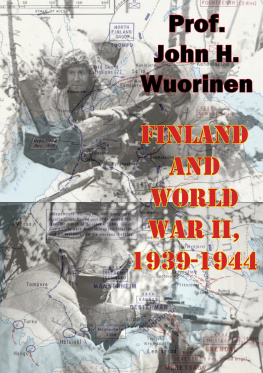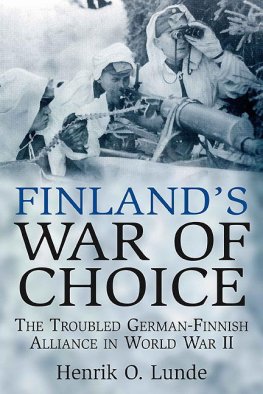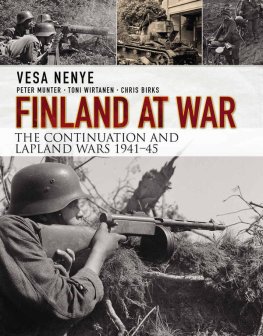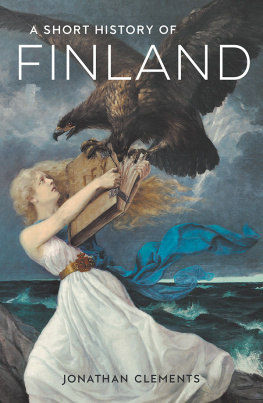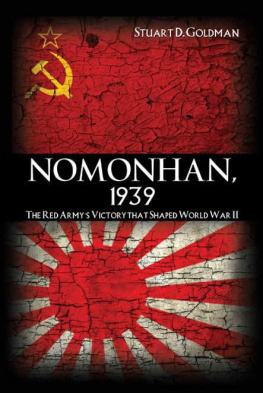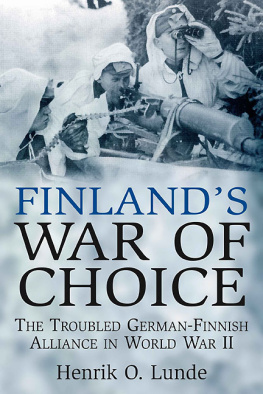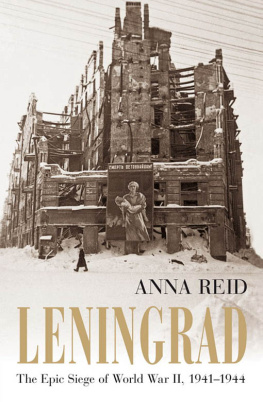

This edition is published by PICKLE PARTNERS PUBLISHINGwww.picklepartnerspublishing.com
To join our mailing list for new titles or for issues with our books picklepublishing@gmail.com
Or on Facebook
Text originally published in 1963 under the same title.
Pickle Partners Publishing 2015, all rights reserved. No part of this publication may be reproduced, stored in a retrieval system or transmitted by any means, electrical, mechanical or otherwise without the written permission of the copyright holder.
Publishers Note
Although in most cases we have retained the Authors original spelling and grammar to authentically reproduce the work of the Author and the original intent of such material, some additional notes and clarifications have been added for the modern readers benefit.
We have also made every effort to include all maps and illustrations of the original edition the limitations of formatting do not allow of including larger maps, we will upload as many of these maps as possible.
FINLAND AND WORLD WAR II 1939-1944
Edited by
JOHN H. WUORINEN, Ph.D.
PROFESSOR OF HISTORY, COLUMBIA UNIVERSITY
TABLE OF CONTENTS
Contents
FOREWORD
The manuscript for this book was received in the United States late in 1945. As far as I know, it is the most important document to come out of Finland since the close of the recent war. It is the first fairly extensive presentation of the Finnish side of the story of how Finland became involved in the war, how the Finns saw and attempted to deal with the baffling problems of the war, and how they finally got out of the war in September, 1944.
The original manuscript came to my attention early in 1946. It was in Finnish. A careful reading of it led to the conclusion that it should be published and made available to the American reader. Having been a student of Finnish history and affairs for over twenty years, and having made a special effort to follow the course of events in Finland since 1939for example, while serving in the Research and Analysis Branch of the Office of the Strategic Services, in 1942-1944I have no hesitation in saying that this book throws a flood of light upon a phase of the second World War which has hitherto been largely left to the mercies of the inexpert and the propagandist. The story here told is, as the reader will discover, a calm and unemotional recital of fact and circumstance. The manner of presentation is, in part, restrained to the point of austerity. There is every reason, as far as I know, for believing that essential facts have not been suppressed in order to present a one-sided plea on Finlands behalf. The book is not a cheap propaganda tract.
It was for these reasons that I undertook to prepare the manuscript for publication. Having thus in a sense fathered this book, parental responsibility prompts me to offer a word or two of explanation regarding authorship and the actual task of editing.
Ever since the Russian (Allied) Control Commission began to preside over Finlands destinies in the autumn of 1944, conditions in Finland have been such as to prevent the publication of serious, objective studies of Finlands part in the war. Russian sensibilities cannot be hurt or suspicions aroused. Especially questions dealing with Russias invasion of Finland in 1939, and with the second phase of the war which began in June, 1941, must either be ignored or discussed in a manner that distorts facts and is in keeping with Russian views which label Finland as a Fascist aggressor intent upon destroying the Soviet Union. A document which tries to give an objective account therefore cannot be published without unpleasant consequences for author and publisher alike. If this were not so, this book would no doubt have been published in Finland months ago, and the name of the Finnish author would occupy the customary place on the title page.
A reading of the book shows clearly that it could have been written only by a man who had access to the necessary information dealing with the crucial years 1939-1944. It is more than likely that the author belongsor belongedamong the top leaders in Finland. There is also reason to believe that more than one pen contributed to the manuscript. The reasons for this surmise must remain unstated, however, lest they defeat the purpose which anonymity is intended to achieve.
The manner of telling the story in the Finnish manuscript does not always lend itself readily to easy translation into English. A deliberate attempt has been made, however, to retain, in the version now published, the idiom of the original. It seemed best to avoid the use of stylistic and other devices which, while no doubt adding to readability, might easily have led to distortions of subject matter. The text therefore corresponds to the Finnish original in all respects. There is but one exception this rule.
The exception is the last or concluding chapter. A reading of the original suggests that this chapter was written in considerable haste. Whatever the reason may have been, it is not well organized and is partly repetitious. I have therefore rearranged its content somewhat and eliminated minor parts of it. It is in this chapter, therefore, that something like genuine editorial function has been performed. Care has been taken, needless to say, to leave out nothing and to add nothing important. In its present form, the last chapter thus contains the reflections and conclusions penned by the author, although a line by line comparison would show some differences between the original and the chapter as it now appears in English.
In preparing the manuscript for publication, it was felt that the American reader would welcome a somewhat more extensiveand somewhat differentintroductory statement than the one that is contained in the first chapter. The main part of the story is therefore preceded by a brief summary, presented in this Foreword, of Finnish economic, political and other developments before the outbreak of the second World War. For the same reason, it was considered pertinent to outline, in equally brief summary form, some of the main results of the war for Finland as the third year of peace draws to a close, and to note the nature and implications of the peace treaty which the Allied and Associated Powers signed with Finland on February 10, 1947. A few explanatory footnotes have also been added.
II
The Finland that fell victim to Soviet invasion in 1939 was unquestionably one of the most successful democracies in Europe. Long-range historical development before the Finns achieved independence in 1917-1918 and exceptional progress during the two decades after 1918 had given the country a place in the front rank of European democratic nations.
Until the time when Jefferson served as President of the United States and Napoleon embarked upon his career of gory conquest, Finland was a part of the Swedish kingdom. For well over 600 years, Sweden and Finland constituted a single state. For some twenty generations, Swede and Finn had been equally subjects of the same crown; they had been partners, as it were, in the upbuilding of common political, religious and social institutions, and both were equally native Swedes as regards political and other rights. Until Finland was separated from Sweden in 1809, the Finns had been, one can say, as self-governing as the Swedes, and had the same long tradition in the arts of government, law, administration and the like.
Finlands connection with Sweden was severed by Russian conquest. The conquest occurred in 1808-1809, and was one of the sideshows of the larger international drama of the time. The inclusion of Finland in the Russian empire did not, however, reduce the country to the status of a subject province. Finland became a self-governing partthe only self-governing partof the empire. Its constitution, laws, courts, church and religion (Lutheran), educational system and economic life were left almost wholly unchanged. Thus autonomous Finland was able to carry on, after 1809, on the basis which the preceding centuries had given to the nation. Foreign affairs were left in Russias hands, to be sure.
Next page
